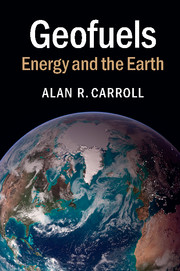Book contents
- Frontmatter
- Contents
- Acknowledgments
- 1 Introduction
- 2 The Living Earth
- 3 Warmed from Above: Solar Energy
- 4 Wind, Water, and Waves: Energy from the Fluid Earth
- 5 Covered in Green: Biofuels Basics
- 6 Fossil Farming: The Geologic Underpinnings of Biofuels
- 7 The Light of an Ancient Sun: Fossil Fuel Origins
- 8 Digging for Daylight: Coal and Oil Shale
- 9 Skimming the Cream: Conventional Oil and Gas
- 10 Stuck in the Mud: Fossil Fuels That Fail to Flow
- 11 Petrified Petroleum: Oil Sand and Gas Hydrate
- 12 Water, Water, Everywhere
- 13 Primordial Power: Geothermal and Nuclear
- 14 Out of Sight, Out of Mind: Geologic Waste Disposal
- 15 How Long Is Forever? Energy and Time
- 16 Conclusions
- Index
- References
13 - Primordial Power: Geothermal and Nuclear
Published online by Cambridge University Press: 05 March 2015
- Frontmatter
- Contents
- Acknowledgments
- 1 Introduction
- 2 The Living Earth
- 3 Warmed from Above: Solar Energy
- 4 Wind, Water, and Waves: Energy from the Fluid Earth
- 5 Covered in Green: Biofuels Basics
- 6 Fossil Farming: The Geologic Underpinnings of Biofuels
- 7 The Light of an Ancient Sun: Fossil Fuel Origins
- 8 Digging for Daylight: Coal and Oil Shale
- 9 Skimming the Cream: Conventional Oil and Gas
- 10 Stuck in the Mud: Fossil Fuels That Fail to Flow
- 11 Petrified Petroleum: Oil Sand and Gas Hydrate
- 12 Water, Water, Everywhere
- 13 Primordial Power: Geothermal and Nuclear
- 14 Out of Sight, Out of Mind: Geologic Waste Disposal
- 15 How Long Is Forever? Energy and Time
- 16 Conclusions
- Index
- References
Summary
At daybreak on July 4, 1054, a Chinese astronomer named Yang Weide noted the appearance of a new “guest star” in the eastern sky, near the more familiar reference star Tianguan (now known as Zeta Tauri). The appearance of a guest star was an exceedingly rare event considered to carry great geopolitical significance; the emperor Renzong therefore was duly notified. The new star remained visible during the daytime for 23 days, and finally disappeared from the night sky after 642 days. At the time, the Song dynasty was a world technological leader, having introduced paper money, gunpowder, and use of the magnetic compass for marine navigation. They did not yet have the telescope, however, and so could not know that the new guest star had been replaced by a much dimmer but still luminescent interstellar cloud, the Crab Nebula (Figure 13.1).
Yang's guest star was in fact a supernova, which has since been named SN 1054. It formed by the collapse of an aging star, which originally had a mass many times that of our own Sun. As it exhausted its core fuel supply, the star eventually reached a point where the energy released by nuclear fusion could no longer counteract the unimaginably large gravitational forces pulling inward. A violent implosion ensued, immediately followed by an explosion that temporarily made SN 1054 one of the brightest objects in the galaxy. Within seconds, the energy of this explosion also spawned a suite of new chemical elements, which were immediately hurled outward into interstellar space. Among them was one of the rarest naturally occurring elements of all, uranium.
Born of extreme violence, uranium remains inherently unstable or “radioactive” for the rest of its life, fated to spontaneous and inexorable decay to lighter elements. Some of these second-generation or “daughter” elements are themselves unstable, experiencing further decay until the process eventually reaches its end with drearily dull but reliably stable lead.
- Type
- Chapter
- Information
- GeofuelsEnergy and the Earth, pp. 261 - 286Publisher: Cambridge University PressPrint publication year: 2015



